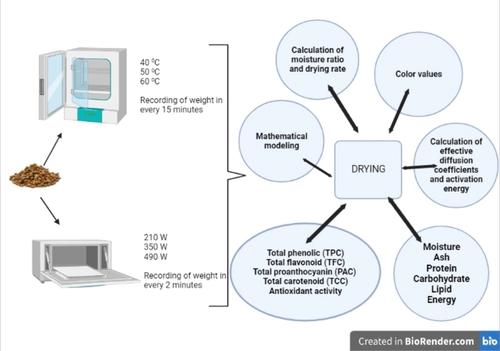当前位置:
X-MOL 学术
›
Chem. Biodivers.
›
论文详情
Our official English website, www.x-mol.net, welcomes your
feedback! (Note: you will need to create a separate account there.)
The Effect of Different Drying Methods on Bioactive and Nutrition Contents of Bee Bread and Mathematical Modeling of Drying Characteristics
Chemistry & Biodiversity ( IF 2.3 ) Pub Date : 2022-11-25 , DOI: 10.1002/cbdv.202200962 Naciye Kutlu 1 , Yusuf Can Gercek 2, 3 , Nesrin Ecem Bayram 1
Chemistry & Biodiversity ( IF 2.3 ) Pub Date : 2022-11-25 , DOI: 10.1002/cbdv.202200962 Naciye Kutlu 1 , Yusuf Can Gercek 2, 3 , Nesrin Ecem Bayram 1
Affiliation

|
In this study, the aim was to determine the effect of different drying methods (with microwave and hot air) on the color, nutrient and bioactive contents of fresh bee bread. Drying characteristics were also investigated. Microwave and hot air drying were applied at different microwave powers and temperatures, respectively. Lower moisture ratios and highest effective diffusion coefficients were obtained with microwave drying in a shorter time. The Midilli model was found to be the most suitable thin-layer drying model for both methods. Regardless of the drying conditions, moisture, ash, protein, carbohydrate, and lipid proportions were observed to vary in the ranges of 4.9–8.2 %, 1.61–2.67 %, 17.47–32.54 %, 39.92–60.84 %, and 7.10–8.89 %, respectively. The lowest color difference was obtained for the sample dried at 210 W. As a result, it was determined that microwave drying is more suitable for preserving the nutritional and bioactive content of bee bread during drying.
中文翻译:

不同干燥方法对蜂面包生物活性和营养成分的影响及干燥特性的数学建模
在这项研究中,目的是确定不同的干燥方法(微波和热风)对新鲜蜂面包的颜色、营养和生物活性含量的影响。还研究了干燥特性。分别在不同的微波功率和温度下应用微波和热风干燥。在较短的时间内用微波干燥获得了较低的水分比和最高的有效扩散系数。发现 Midilli 模型是最适合这两种方法的薄层干燥模型。无论干燥条件如何,观察到水分、灰分、蛋白质、碳水化合物和脂质比例在 4.9–8.2%、1.61–2.67%、17.47–32.54%、39.92–60.84% 和 7.10–8.89% 的范围内变化, 分别。在 210 W 下干燥的样品获得了最低的色差。结果,
更新日期:2022-11-25
中文翻译:

不同干燥方法对蜂面包生物活性和营养成分的影响及干燥特性的数学建模
在这项研究中,目的是确定不同的干燥方法(微波和热风)对新鲜蜂面包的颜色、营养和生物活性含量的影响。还研究了干燥特性。分别在不同的微波功率和温度下应用微波和热风干燥。在较短的时间内用微波干燥获得了较低的水分比和最高的有效扩散系数。发现 Midilli 模型是最适合这两种方法的薄层干燥模型。无论干燥条件如何,观察到水分、灰分、蛋白质、碳水化合物和脂质比例在 4.9–8.2%、1.61–2.67%、17.47–32.54%、39.92–60.84% 和 7.10–8.89% 的范围内变化, 分别。在 210 W 下干燥的样品获得了最低的色差。结果,











































 京公网安备 11010802027423号
京公网安备 11010802027423号